I have a QListWidget and a QGraphicsView both subclassed to overwrite some of their members. I prepared a minimal verifiable example showing the problem I have here
From the QListWidget I can drag and drop specific field (represented by a QTableWidget) and drop them into a QGraphicsView and in order to do that I am using a QGraphicsProxyWidget approach as shown below.
The Problem
Now, how do I connect 2 QRadioButton inside cell of a QTableWidget with another cell of another QTableWidget?
It is important to mention that the green QGraphicsRectItem it is used to move around the QTableWidget as well as adjusting its dimension.
Below the result I was able to arrive so far:

And below the expected result I have been trying to achieve:

Below the most important part of the code:
scene.h
#ifndef SCENE_H
#define SCENE_H
#include <QGraphicsScene>
class Scene : public QGraphicsScene
{
public:
Scene(QObject *parent = nullptr);
protected:
void dragEnterEvent(QGraphicsSceneDragDropEvent *event);
void dragMoveEvent(QGraphicsSceneDragDropEvent *event);
void dropEvent(QGraphicsSceneDragDropEvent *event);
};
#endif // SCENE_H
scene.cpp
#include "arrow.h"
#include <QGraphicsSceneDragDropEvent>
#include <QMimeData>
#include <QTableWidget>
#include <QGraphicsProxyWidget>
#include <QVBoxLayout>
#include <QMetaEnum>
#include <QEvent>
#include <QSizeGrip>
#include <QRadioButton>
Scene::Scene(QObject *parent)
{
setBackgroundBrush(Qt::lightGray);
}
void Scene::dragEnterEvent(QGraphicsSceneDragDropEvent *event) {
if (event->mimeData()->hasFormat("application/x-qabstractitemmodeldatalist"))
event->setAccepted(true);
}
void Scene::dragMoveEvent(QGraphicsSceneDragDropEvent *event) {
if (event->mimeData()->hasFormat("application/x-qabstractitemmodeldatalist"))
event->setAccepted(true);
}
void Scene::dropEvent(QGraphicsSceneDragDropEvent *event) {
QByteArray encoded =
event->mimeData()->data("application/x-qabstractitemmodeldatalist");
QDataStream stream(&encoded, QIODevice::ReadOnly);
QStringList rosTables;
QString newString;
while (!stream.atEnd()) {
int row, col;
QMap<int, QVariant> roleDataMap;
stream >> row >> col >> roleDataMap;
rosTables << roleDataMap[Qt::DisplayRole].toString();
}
for (const QString &tableType : rosTables) {
if (tableType == "Images") {
QPoint initPos(0, 0);
auto *wgt = new CustomTableWidget;
auto *proxyControl = addRect(0, 0, 0, 0, QPen(Qt::black),
QBrush(Qt::darkGreen));
auto *sizeGrip = new QSizeGrip(wgt);
auto *layout = new QHBoxLayout(wgt);
layout->setContentsMargins(0, 0, 0, 0);
layout->addWidget(sizeGrip, 0, Qt::AlignRight | Qt::AlignBottom);
connect(wgt, &CustomTableWidget::sizeChanged, [wgt, proxyControl](){
proxyControl->setRect(wgt->geometry().adjusted(-10, -10, 10, 10));
});
wgt->setColumnCount(4);
wgt->setRowCount(4);
for (int ridx = 0; ridx < wgt->rowCount(); ridx++) {
for (int cidx = 0; cidx < wgt->columnCount(); cidx++) {
QRadioButton *radio1, *radio2;
auto* item = new QTableWidgetItem();
item->setText(QString("%1").arg(ridx));
wgt->setItem(ridx,cidx,item);
radio1 = new QRadioButton;
radio2 = new QRadioButton;
wgt->setCellWidget(cidx, 0, radio1);
wgt->setCellWidget(cidx, 3, radio2);
Arrow *arrow = new Arrow;
}
}
auto *const proxy = addWidget(wgt);
proxy->setPos(initPos.x(), initPos.y()
+ proxyControl->rect().height());
proxy->setParentItem(proxyControl);
proxyControl->setPos(initPos.x(), initPos.y());
proxyControl->setFlag(QGraphicsItem::ItemIsMovable, true);
proxyControl->setFlag(QGraphicsItem::ItemIsSelectable, true);
proxyControl->setRect(wgt->geometry().adjusted(-10, -10, 10, 10));
}
}
}
diagramitem.h
#ifndef DIAGRAMITEM_H
#define DIAGRAMITEM_H
#include <QGraphicsPolygonItem>
class Arrow;
class DiagramItem : public QGraphicsPolygonItem
{
public:
DiagramItem(QMenu *contextMenu, QGraphicsItem *parent = Q_NULLPTR);
void removeArrow(Arrow *arrow);
void removeArrows();
void addArrow(Arrow *arrow);
QPixmap image() const;
protected:
void contextMenuEvent(QGraphicsSceneContextMenuEvent *event) override;
QVariant itemChange(GraphicsItemChange change, const QVariant &value) override;
private:
QPolygonF myPolygon;
QList<Arrow*> arrows;
QMenu *myContextMenu;
};
#endif // DIAGRAMITEM_H
diagramitem.cpp
#include "diagramitem.h"
#include "arrow.h"
#include <QPainter>
#include <QGraphicsScene>
#include <QGraphicsSceneContextMenuEvent>
#include <QMenu>
DiagramItem::DiagramItem(QMenu *contextMenu, QGraphicsItem *parent) : QGraphicsPolygonItem(parent)
{
myContextMenu = contextMenu;
setPolygon(myPolygon);
setFlag(QGraphicsItem::ItemIsMovable, true);
setFlag(QGraphicsItem::ItemIsSelectable, true);
setFlag(QGraphicsItem::ItemSendsGeometryChanges, true);
}
void DiagramItem::removeArrow(Arrow *arrow)
{
int index = arrows.indexOf(arrow);
if (index != -1)
arrows.removeAt(index);
}
void DiagramItem::removeArrows()
{
foreach (Arrow *arrow, arrows) {
arrow->startItem()->removeArrow(arrow);
arrow->endItem()->removeArrow(arrow);
scene()->removeItem(arrow);
delete arrow;
}
}
void DiagramItem::addArrow(Arrow *arrow)
{
arrows.append(arrow);
}
void DiagramItem::contextMenuEvent(QGraphicsSceneContextMenuEvent *event)
{
scene()->clearSelection();
setSelected(true);
myContextMenu->exec(event->screenPos());
}
QVariant DiagramItem::itemChange(QGraphicsItem::GraphicsItemChange change, const QVariant &value)
{
if (change == QGraphicsItem::ItemPositionChange) {
foreach (Arrow *arrow, arrows) {
arrow->updatePosition();
}
}
return value;
}
arrow.h
#ifndef ARROW_H
#define ARROW_H
#include <QGraphicsLineItem>
#include "diagramitem.h"
class Arrow : public QGraphicsLineItem
{
public:
enum { Type = UserType + 4 };
Arrow(DiagramItem *startItem, DiagramItem *endItem,
QGraphicsItem *parent = nullptr);
DiagramItem *startItem() const { return myStartItem; }
DiagramItem *endItem() const { return myEndItem; }
QPainterPath shape() const override;
void setColor(const QColor &color) {
myColor = color;
}
int type() const override { return Type; }
void updatePosition();
protected:
void paint(QPainter *painter, const QStyleOptionGraphicsItem *option, QWidget *widget = nullptr) override;
private:
QColor myColor;
DiagramItem *myStartItem;
DiagramItem *myEndItem;
QPolygonF arrowHead;
};
#endif // ARROW_H
arrow.cpp
#include "arrow.h"
#include <QPen>
#include <QPainter>
#include "qmath.h"
Arrow::Arrow(DiagramItem *startItem, DiagramItem *endItem, QGraphicsItem *parent) : QGraphicsLineItem(parent)
{
myStartItem = startItem;
myEndItem = endItem;
myColor = Qt::GlobalColor::black;
setPen(QPen(myColor, 2, Qt::SolidLine, Qt::RoundCap, Qt::RoundJoin));
setFlag(QGraphicsItem::ItemIsSelectable, true);
}
QPainterPath Arrow::shape() const
{
QPainterPath path = QGraphicsLineItem::shape();
path.addPolygon(arrowHead);
return path;
}
void Arrow::updatePosition()
{
QLineF line(mapFromItem(myStartItem, 0, 0), mapFromItem(myEndItem, 0, 0));
setLine(line);
}
void Arrow::paint(QPainter *painter, const QStyleOptionGraphicsItem *option, QWidget *widget)
{
Q_UNUSED(option)
Q_UNUSED(widget)
if (myStartItem->collidesWithItem(myEndItem))
return;
QPen myPen = pen();
myPen.setColor(myColor);
qreal arrowSize = 20;
painter->setPen(myPen);
painter->setBrush(myColor);
QLineF centerLine(myStartItem->pos(), myEndItem->pos());
QPolygonF endPolygon = myEndItem->polygon();
QPointF p1 = endPolygon.first() + myEndItem->pos();
QPointF p2;
QPointF intersectPoint;
QLineF polyLine;
for (int i = 1; i < endPolygon.count(); ++i) {
p2 = endPolygon.at(i) + myEndItem->pos();
polyLine = QLineF(p1, p2);
QLineF::IntersectType intersectType =
polyLine.intersect(centerLine, &intersectPoint);
if (intersectType == QLineF::BoundedIntersection)
break;
p1 = p2;
}
setLine(QLineF(intersectPoint, myStartItem->pos()));
double angle = std::atan2(-line().dy(), line().dx());
QPointF arrowP1 = line().p1() + QPointF(sin(angle + M_PI / 3) * arrowSize,
cos(angle + M_PI / 3) * arrowSize);
QPointF arrowP2 = line().p1() + QPointF(sin(angle + M_PI - M_PI / 3) * arrowSize,
cos(angle + M_PI - M_PI / 3) * arrowSize);
arrowHead.clear();
arrowHead << line().p1() << arrowP1 << arrowP2;
painter->drawLine(line());
painter->drawPolygon(arrowHead);
if (isSelected()) {
painter->setPen(QPen(myColor, 1, Qt::DashLine));
QLineF myLine = line();
myLine.translate(0, 4.0);
painter->drawLine(myLine);
myLine.translate(0,-8.0);
painter->drawLine(myLine);
}
}
What I have done so far to solve the problem:
1) I came across this post which was useful to understand the initial idea on how to do that, but it didn't really provide a way, or an implementation idea on how to best proceed
2) I researched the official documentation and before asking this question I went through the whole Diagram Scene example provided and understood how to create an Arrow object. The documentation about that was very good and made me understand how the graphics line item has to be formed.
However I was not able (coming back to my example) how to make "aware" the QRadioButton that I am trying to use its center as starting point for an arrow ad, therefore, how do I make "aware" the destination QRadioButton in another cell that it has to be connected there?
Below a particular of what I mean:

So basically the start point of the QRadioButton change color (or style) and the arrival point also change color.
3) I thought that the Arrow object has to be created inside the subclassed QGraphicsScene since it already handles the mouse events.
4) Despite what I tried so far I could not find any other useful help. Although I am still investigating how to do that.
If anyone has ever been in the same situation please provide guidance on how to better proceed to solve this problem and find a solution to this issue.
